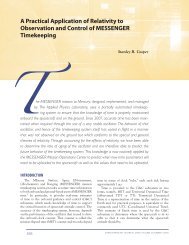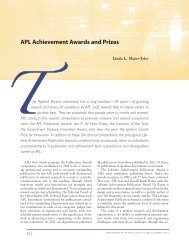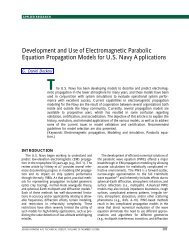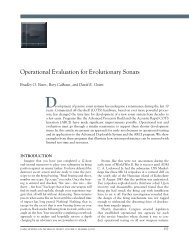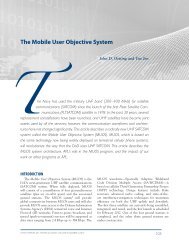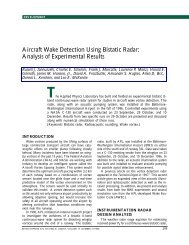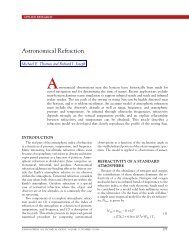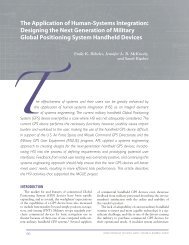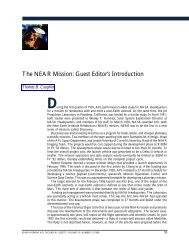The SATRACK System: Development and Applications
The SATRACK System: Development and Applications
The SATRACK System: Development and Applications
You also want an ePaper? Increase the reach of your titles
YUMPU automatically turns print PDFs into web optimized ePapers that Google loves.
included 4 of the described D5X flights <strong>and</strong> 15 later<br />
PEM, DASO, <strong>and</strong> Comm<strong>and</strong>er-in-Chief Evaluation<br />
Test flights. 11 Excellent results were obtained with this<br />
very early test sample, <strong>and</strong> subsequent evaluations<br />
have contributed significantly to improvements in the<br />
underlying weapon system error models. A companion<br />
article (Coleman <strong>and</strong> Simkins, this issue) describes the<br />
significant contributions achieved by the cumulative<br />
processing methodology.<br />
Other <strong>Applications</strong><br />
At about the same time as <strong>SATRACK</strong> II development<br />
was beginning, the Range <strong>Applications</strong> Joint<br />
Program Office (RAJPO) initiated development of a<br />
translator for general missile test applications. APL<br />
provided technical support to RAJPO, <strong>and</strong> they eventually<br />
initiated a contract with Interstate Electronics<br />
Corporation to produce a ballistic missile translator<br />
(BMT) system for general-purpose range applications.<br />
<strong>The</strong> BMT provided an important test capability for<br />
numerous National Missile Defense (NMD) test flights<br />
that we have been supporting since the early 1990s.<br />
A special adaptation of the BMT was also used for two<br />
Air Force Peacekeeper ICBM flight tests that the<br />
Laboratory supported.<br />
<strong>The</strong> first NMD test support we provided was for two<br />
exo-atmospheric reentry intercept subsystem (ERIS)<br />
test flights in January 1991 <strong>and</strong> March 1992. <strong>The</strong>se<br />
tests demonstrated that differential GPS measurements<br />
between an interceptor <strong>and</strong> target, each equipped with<br />
a translator, could resolve the intercept vector geometry<br />
with submeter accuracy. <strong>The</strong> direct follow-on<br />
project of postflight tracking <strong>and</strong> analysis support to<br />
NMD is continuing, with the most recent intercept test<br />
series planned into 1999. <strong>The</strong> ERIS tests acted as a<br />
springboard to a series of independent research <strong>and</strong><br />
development (IR&D) activities directed at achieving<br />
intercept vector geometry accuracy of less than 2 cm.<br />
<strong>The</strong> ability to achieve that level of accuracy was demonstrated<br />
with an IR&D project based on the use of a<br />
recently developed <strong>SATRACK</strong> instrumentation.<br />
<strong>The</strong> U.S. Air Force Peacekeeper test support was a<br />
direct spin-off of the Navy Trident work. <strong>The</strong> postflight<br />
tracking <strong>and</strong> analysis work had the same general<br />
evaluation objectives for individual tests. However,<br />
with only two Peacekeeper flights evaluated using<br />
<strong>SATRACK</strong>, no basis for cumulative analysis existed.<br />
APL <strong>and</strong> the Charles Stark Draper Laboratory supported<br />
Peacekeeper contractors (TRW <strong>and</strong> Rockwell International)<br />
in a successful technology transfer of the<br />
Navy guidance evaluation capabilities. 12,13<br />
All objectives of the program were met. Of particular<br />
importance, the two tests showed that the GPS<br />
estimation uncertainties were better than the best<br />
available radar-based evaluation approach. Specifically,<br />
THE <strong>SATRACK</strong> SYSTEM<br />
this test experience demonstrated the superiority of<br />
GPS over radar for evaluating inertial measurement<br />
unit hardware errors. In addition, it was concluded that<br />
GPS would provide highly accurate instantaneous impact<br />
point data for range safety. 12,13 Although success<br />
was achieved with the <strong>SATRACK</strong> approach, the<br />
Peacekeeper program was meeting its objectives with<br />
the available radar instrumentation. <strong>The</strong>refore, the<br />
Air Force had no motivation to change its evaluation<br />
approach. However, Air Force reports recognized that<br />
the <strong>SATRACK</strong> methodology uncovered a previously<br />
undetected initial condition error. This finding led to<br />
a reassessment of the gravity model in the launch area<br />
<strong>and</strong> its influence on the Peacekeeper guidance model.<br />
<strong>SATRACK</strong> III<br />
<strong>The</strong> Navy will continue to test <strong>and</strong> evaluate the<br />
Trident Weapon <strong>System</strong> with the primary goals of detecting<br />
changes to system performance caused by aging<br />
components <strong>and</strong> assessing system modifications needed<br />
to extend its lifetime. In this regard, we recognize<br />
that <strong>SATRACK</strong> evaluation is only one part of system<br />
accuracy assessment, <strong>and</strong> accuracy assessment is only<br />
a part of the total weapon system evaluation. Equal<br />
diligence is needed in all aspects of monitoring <strong>and</strong><br />
maintaining the Trident system.<br />
Continued D5 accuracy evaluation support will<br />
remain the primary objective for <strong>SATRACK</strong>. However,<br />
in parallel with this activity, we have identified a<br />
natural extension of <strong>SATRACK</strong> capabilities that can<br />
support precision intercept evaluations for national<br />
<strong>and</strong> theater ballistic missile defense flight tests. This<br />
realization grew out of our ERIS flight test experience<br />
<strong>and</strong> our support to the Strategic Defense Initiative<br />
Organization for the development of a precision intercept<br />
test capability for the Brilliant Pebbles Program.<br />
Both of these projects <strong>and</strong> the continued support of<br />
NMD test objectives have, with Navy concurrence,<br />
taken advantage of the unique APL facilities developed<br />
for Trident. As noted in a companion article<br />
(Thompson, this issue) on a high-precision sled test,<br />
we successfully completed an IR&D project devoted to<br />
demonstrating the measurement capability needed for<br />
precision intercept test evaluations. An earlier IR&D<br />
project developed a translator design for this purpose<br />
that was the basis for a new Trident translator system<br />
used for supporting special reentry body tests.<br />
<strong>The</strong> upgraded <strong>SATRACK</strong> postflight tracking facility<br />
will support existing C4 <strong>and</strong> D5 translators <strong>and</strong><br />
reentry body translators as well as the replacement<br />
translator to be selected for the new D5 test missile<br />
kit. When completed, we will refer to this configuration<br />
as <strong>SATRACK</strong> III, which will take full advantage<br />
of technology growth in processing hardware <strong>and</strong><br />
software to produce a workstation-based facility that<br />
JOHNS HOPKINS APL TECHNICAL DIGEST, VOLUME 19, NUMBER 4 (1998) 445




